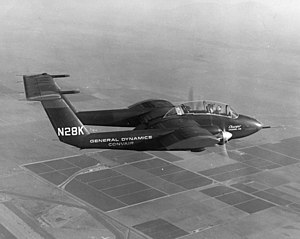Convair Charger
| Convair Model 48 Charger | |
|---|---|

|
|
| Type: | light attack and reconnaissance aircraft |
| Design country: | |
| Manufacturer: | |
| First flight: |
November 25, 1964 |
| Commissioning: |
never put into service |
| Production time: |
never mass-produced |
| Number of pieces: |
1 |
The Convair Model 48 Charger (warhorse) is a two-seater, two- turbo- propelled, light observation, attack and transport aircraft with short take-off and landing capabilities from Consolidated Vultee Aircraft Corporation , or Convair for short. It is also the last aircraft developed by this company, as Convair turned to other areas of activity after the Convair Coronado program expired and the order for the Charger was lost. The prototype of the Charger remained a unique piece.
Development history
Experience from the Korean War resulted in a tender by the US Department of Defense on October 28, 1963, seeking a light, armed reconnaissance aircraft that was specifically suitable for counterinsurgency operations (COIN) and could be used by all branches of the armed forces. The O-1 Bird Dog and O-2 Skymaster models - both derived from propeller-driven private aircraft - were unsuitable for this purpose.
Representing the acquired US Navy to lead the project LARA ( L ight A rmed R econnaissance A ircraft), looked with specifications as follows:
It should be a twin-engine, propeller-driven aircraft with a crew of two, which should combine certain criteria of both a helicopter and a jet-propelled aircraft. A very small span was given in order to be able to operate from the streets. At a speed of up to 560 km / h, extremely resilient flight characteristics (−3 to +8 g) and a maximum take-off and landing distance of 250 m, it should also be able to carry a load of up to 1100 kg. This should, for example, consist of up to six fully equipped paratroopers or two stretchers and a paramedic. It should also be able to operate from aircraft carriers .
The internal armament should consist of four machine guns of 7.62 mm caliber including 500 rounds of ammunition, and there should be outstations for Sidewinder rockets and an external machine cannon of 20 mm caliber.
The Convair Charger was one of the 9 submitted designs.
In August 1964, however, the US Navy decided on very similar-looking models NA-300 and Rockwell OV-10 from the North American / Rockwell consortium . Nevertheless, an order for flight tests with the Charger was placed for some flights as part of a pilot test.
A few months after the start of the program, on November 25, 1964, the prototype, initially built on Convair's own initiative, had its maiden flight. He started with test pilot Johnny Knebel from Lindbergh Field in San Diego on a short test flight, which however revealed some problems. The control and the flight behavior were problematic due to the short wings and the large horizontal stabilizer. The wing was then lengthened by around 92 centimeters and the ends rounded. Another problem was the extreme volume during take-off (especially in the cockpit), which was due to the propeller tips passing very close to the cockpit wall.
The end for the machine (there was still hope that the order would be changed) came on October 19, 1965, when the prototype got out of control on landing and crashed as a result of several pilot errors by Navy pilot Dave Harden. The pilot was able to save himself with the ejection seat, but the machine was completely destroyed. So the prototype of the Charger remained a one-off.
Technical specifications
The Charger was an unusual-looking aircraft with a short fuselage, but two thick extensions that ran out behind the engines and carried the double-T tail . The engines were a military version of the PT6A-24 turboprops from Pratt & Whitney . In order to guarantee the short take-off and short landing properties, large extendable flaps were attached to the trailing edges of the wings , which directed the airflow from the propellers downwards. The thrust of the engines supported the lift of the wings. This meant that the Charger was able to get by with a 70 m take-off distance and a less than ten meters landing distance. The chassis, which is robustly designed for use on roads, with low-pressure tires and shock absorbers, made this not very gentle landing possible. The cockpit, designed for easy operation, had an ejector seat for the pilot and observer in an emergency .
| Model 48 Charger | |
|---|---|
| Type | Light attack aircraft |
| crew | 1-2 |
| span | 8.38 m |
| length | 10.61 m |
| height | 4.14 m |
| Wing area | 17.84 m² |
| Empty mass | 2022 kg |
| Max. Takeoff mass | 3220 kg |
| Top speed (at sea level) | 510 km / h |
| Start distance (over a 15 m obstacle) | Less than 150 m |
| Landing route | Less than 150 m |
| Transfer range | 4825 km |
| Duration of use | 2 hours |
| Engines | 2 × Pratt & Whitney Canada YT74-CP-8 with 410 kW each (later 559 kW) |
| Armament |
|
Web links
swell
- ↑ FlugRevue August 2008, pp. 100-103, The last war horse
